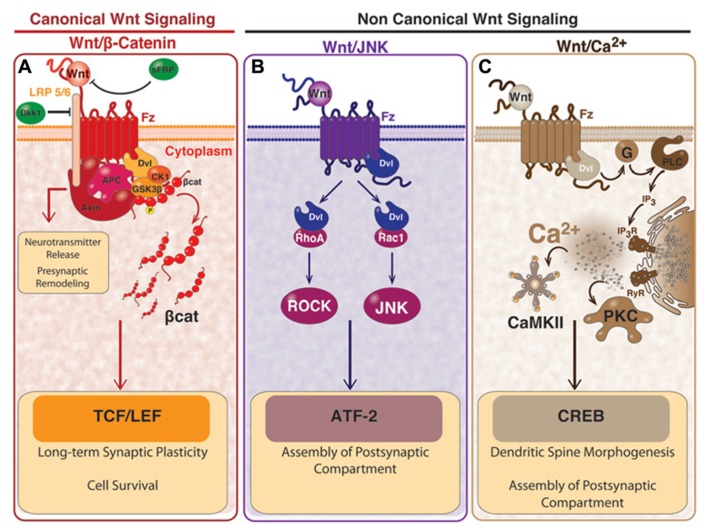FIGURE 1.
Wnt signaling pathways and the effects in mature synapses. (A) activation of canonical Wnt/β-catenin dependent pathway starts with the binding of Wnt ligand to Fz receptor and to the co-receptor LRP5/6, which induces the recruitment of Dvl and causes the inhibition of the “β-catenin destruction complex” formed by Axin, APC, GSK3β, and CK1. The inhibition of the “β-catenin destruction complex” causes the accumulation of β-catenin, which is no longer phosphorylated and it translocates to the nucleus where it activates transcription of Wnt target genes mediated by TCF/LEF. Canonical Wnt pathway participates in synaptic plasticity and cell survival. A divergent pathway involving proteins of the “β-catenin destruction complex” participates in the clustering of pre-synaptic proteins and the neurotransmitter release. The Wnt/β-catenin pathway can be blocked by Dkk-1 which binds to LRP, or through the sFRP which binds directly to Wnt ligand. (B) In the non-canonical Wnt/JNK pathway, activation of Dvl by the binding of Wnt to Fz, induces the activation of Rho and Rac small GTPases. Activation of Rho signals through ROCK and the activation of Rac signals through the JNK. This pathway is involved in the clustering of post-synaptic proteins and can also lead gene transcription mediated by ATF2. (C) In the non-canonical Wnt/Ca2+ pathway, the binding of Wnt to Fz, activates the heterotrimeric G-proteins which in turn signal through PLC and IP3 to induce the release of the intracellular Ca2+ and the activation of PKC and CaMKII. In this pathway, the transcription factor CREB is activated. Wnt/Ca2+ pathway is involved in the clustering of post-synaptic proteins and the dendritic spine morphogenesis. This figure is a courtesy of Felipe Serrano, Ph.D. student.

